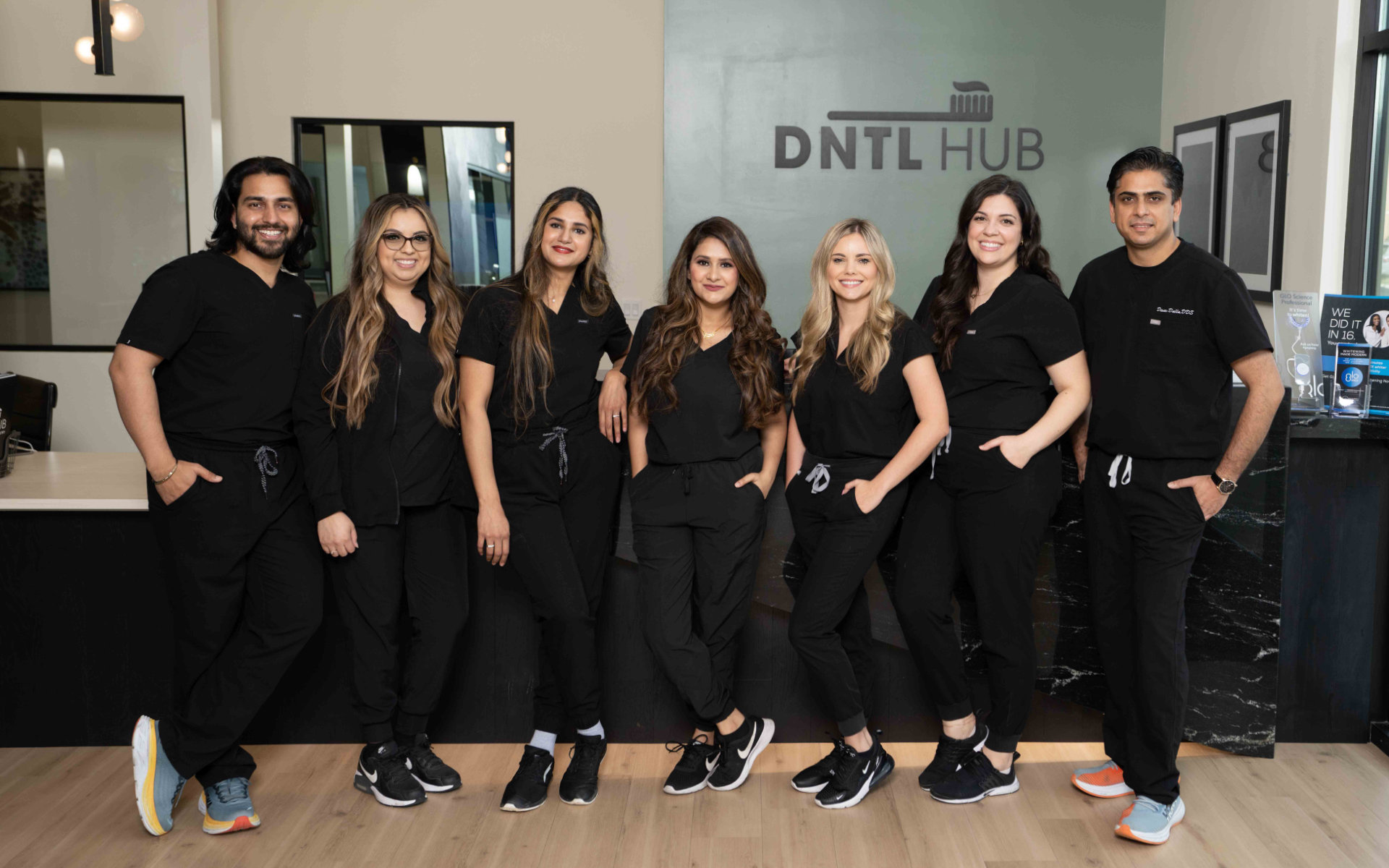
At DNTL Hub in Galt, our dental team regularly treats patients with receding gums—a condition that affects nearly 88% of people over 65 and up to 50% of adults worldwide. This common dental issue not only impacts your smile’s appearance but can lead to serious oral health complications when left untreated.
What Exactly Is Gum Recession?
Gum recession occurs when the margin of gum tissue surrounding the teeth wears away or pulls back, exposing more of the tooth or the tooth’s root. As a progressive condition, gum recession begins subtly but can advance significantly if not addressed properly.
The American Academy of Periodontology identifies gum recession as one of the most common periodontal conditions, often going unnoticed until symptoms become pronounced. Many of our Galt patients are surprised to learn they have receding gums during routine dental examinations at DNTL Hub.
Primary Causes of Receding Gums in Galt Patients
Understanding what causes gum recession is essential for effective prevention and treatment. Based on clinical data and our experience with Galt patients, these factors most frequently contribute to gum recession:
- Periodontal Disease Bacterial infections that destroy gum tissue and the supporting bone are responsible for approximately 70% of gum recession cases. These infections often begin with gingivitis before progressing to more serious periodontitis.
- Improper Brushing Techniques Using a hard-bristled toothbrush or aggressive brushing motions can physically wear away gum tissue over time. The American Dental Association reports that nearly 30% of recession cases stem from traumatic brushing habits.
- Genetic Predisposition Studies published in the Journal of Periodontology indicate that up to 30% of the population may be genetically susceptible to gum disease regardless of their oral hygiene practices. Thin gingival tissue, a genetic trait, makes some Galt patients particularly vulnerable.
- Tobacco Use Smokers are twice as likely to develop gum recession compared to non-smokers. Tobacco restricts blood flow to gum tissues and compromises the immune system’s ability to fight infection.
- Bruxism (Teeth Grinding) Excessive force from grinding or clenching places pressure on teeth and gums, accelerating recession. Nearly 15% of our Galt patients exhibit signs of nighttime bruxism.
- Misaligned Bite or Crooked Teeth When teeth don’t align properly, uneven force distribution can lead to gum recession in areas with excessive pressure. Orthodontic treatment may be recommended alongside gum treatment.
- Hormonal Fluctuations Changes in hormone levels during pregnancy, menopause, or other life stages increase inflammation and sensitivity in gum tissues, creating vulnerability to recession.
Clinical Signs That Galt Residents Should Not Ignore
Dr. Dalla and our DNTL Hub team recommend seeking evaluation if you notice any of these symptoms:
- Tooth Sensitivity Pain or discomfort when consuming hot, cold, or sweet items often indicates exposed root surfaces
- Visible Root Surface Noticing that teeth appear longer than before or seeing a yellowish root surface where pink gum tissue should be
- Interdental Space Enlargement Increasing spaces or “black triangles” between teeth where gum tissue has receded
- Recession Line A visible notch or indentation where the gum and tooth meet, often detectable with the tongue
- Inflammation Signs Persistent redness, bleeding, or tenderness along the gum margin
“The concerning aspect of gum recession is its irreversible nature,” explains Dr. Dalla of DNTL Hub in Galt. “While we can’t regrow natural gum tissue, we can halt progression and restore the protective function with proper intervention. The earlier we diagnose recession, the more conservative our treatment approach can be.”
Evidence-Based Treatment Options Available at DNTL Hub Galt
Our practice offers comprehensive treatment protocols based on the latest dental research and clinical guidelines:
Non-Surgical Interventions
- Scaling and Root Planing This gold-standard deep cleaning procedure removes bacterial deposits from below the gum line with effectiveness rates of 80-90% for halting early recession progression.
- Occlusal Adjustment For patients with bite-related recession, subtle modifications to how teeth meet can redistribute forces more evenly, reducing further damage.
- Desensitizing Treatments Professional-grade desensitizing agents containing potassium nitrate or stannous fluoride provide relief while strengthening vulnerable areas.
Advanced Surgical Solutions
- Connective Tissue Grafts The most common type of gum graft, with success rates of 85-95%. This procedure uses tissue from the palate to cover exposed roots and reinforce thin gums.
- Free Gingival Grafts Ideal for patients with naturally thin gum tissue, this technique builds up the band of keratinized gingiva for long-term stability.
- Pinhole Surgical Technique A minimally invasive alternative to traditional grafting that repositions existing gum tissue without incisions or sutures, resulting in faster recovery.
- Guided Tissue Regeneration Advanced biocompatible membranes promote the regrowth of bone and tissue lost to severe periodontal disease.
Research published in the International Journal of Periodontics & Restorative Dentistry demonstrates that patients who undergo appropriate surgical intervention experience an average of 3.8mm of recession coverage with significant reductions in sensitivity.
Prevention Strategies Based on Clinical Evidence
Our Galt dental team recommends these evidence-based approaches to prevent gum recession:
- Proper Brushing Technique Use a soft-bristled toothbrush at a 45-degree angle with gentle circular motions. Electric toothbrushes with pressure sensors show a 20% reduction in brushing-related gum trauma.
- Regular Professional Cleanings Patients who maintain biannual dental visits have 65% lower rates of severe periodontitis compared to those who visit only when experiencing problems.
- Customized Night Guards For bruxism patients, custom-fitted occlusal appliances reduce damaging forces by up to 70% during sleep.
- Targeted Nutritional Support Vitamin C intake of at least 90mg daily supports collagen production essential for gum health, while omega-3 fatty acids reduce inflammatory responses.
- Tobacco Cessation Studies show that former smokers who quit for at least one year show significant improvement in gum health and reduced recession progression.
At DNTL Hub, we develop personalized prevention plans for our Galt patients based on their specific risk factors and oral health status.
The Galt DNTL Hub Advantage: Our Comprehensive Approach
Our Galt practice distinguishes itself through evidence-based, patient-centered care for gum recession:
“At DNTL Hub, we utilize digital imaging technology that can detect early gum changes before they’re visible to the naked eye,” shares our clinical team. “This allows us to intervene with minimally invasive techniques before significant recession occurs.”
For Galt residents with established recession, we offer a multi-disciplinary approach that may combine periodontal treatment, restorative procedures, and ongoing maintenance therapy tailored to individual needs.
Take Action: Protect Your Gum Health
If you’ve noticed any signs of gum recession or it’s been over six months since your last comprehensive dental examination, we encourage you to contact our Galt office. The team at DNTL Hub provides thorough evaluations that assess not only your current gum condition but also identify risk factors that may contribute to future recession.
Serving the Galt, Lodi, and Elk Grove communities at our 10360 Twin Cities Rd location, DNTL Hub offers convenient appointment scheduling at 209-916-1000. Don’t wait until recession progresses—early intervention is key to preserving your natural smile and avoiding more extensive treatment.
Posted on behalf of
10360 Twin Cities Rd, Ste 10
Galt, CA 95632
Phone: 209-916-1000
Email: info@dntlhub.com
Monday - Thursday
8:00am - 5:00pm
Friday 8:00am - 4:00pm

